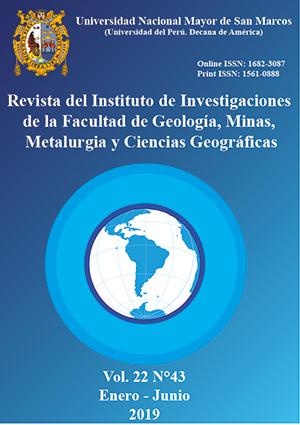Lithogeochemistry characterization of rare earth elements in rocks of Eastern Cordilleran at the Center of Peru and its potential to generate mineral deposits
DOI:
https://doi.org/10.15381/iigeo.v22i43.16690Keywords:
Lithogeochemistry; REE; potential; center of PeruAbstract
In Peru, rocks with interesting composition in Rare Earth Elements (REE) elements are batholiths and stocks of alkaline to peralkaline tendency, also related to U-Th deposits. However, an important mineral deposit of Rare Earth Elements (REE) has not yet been discovered.
In this work a selective sampling of intrusive rocks was carried out and they took 234 geochemical data, that based on the diagram of total alkalis vs silica indicate that the rocks of the permotriassic are of alkaline tendency; while their volcanics are of a tholeiitic tendency.
In the Carboniferous they are of alkaline tendency, and a series of rocks peralkalines has been recognized. In the Oligocene are calc-alkali, as well as some rocks of the Eocene and Miocene. While some dacitic lavas and intrusions of the Eocene and Miocene show a tholeiitic tendency.
Based on the alumina index we have peraluminous and peralkaline permotriassic intrusives, with peralkaline rocks being the most prominent. Permotriassic lavas are more peraluminous, as in the Carboniferous. Oligocene, Eocene and Miocene volcanic rocks are found between the interface of metaluminous to peraluminous. The lavas and subvolcanic bodies of the Cenozoic and Pliocene all fall between the boundary between metaluminous and peraluminous.
Finally, the bodies of intrusive peralkaline composition in the Eastern Cordillera of Central Peru show anomalous Rare Earth Elements (REE) concentrations and rocks more evolved with cortical contamination; hence, there are zones with geological potential to find a mineral deposit in REE in the Central Peru.
Downloads
Published
Issue
Section
License
Copyright (c) 2019 Michael Valencia Muñoz

This work is licensed under a Creative Commons Attribution-NonCommercial-ShareAlike 4.0 International License.
AUTHORS RETAIN THEIR RIGHTS:
a. Authors retain their trade mark rights and patent, and also on any process or procedure described in the article.
b. Authors retain their right to share, copy, distribute, perform and publicly communicate their article (eg, to place their article in an institutional repository or publish it in a book), with an acknowledgment of its initial publication in the Rev. Inst. investig. Fac. minas metal cienc. geogr.
c. Authors retain theirs right to make a subsequent publication of their work, to use the article or any part thereof (eg a compilation of his papers, lecture notes, thesis, or a book), always indicating the source of publication (the originator of the work, journal, volume, number and date).






